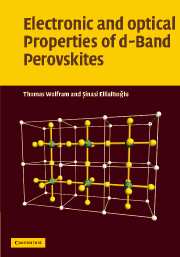Book contents
- Frontmatter
- Contents
- Preface
- 1 Introductory discussion of the perovskites
- 2 Review of the quantum mechanics of N-electron systems
- 3 Empirical LCAO model
- 4 LCAO energy band model for cubic perovskites
- 5 Analysis of bands at symmetry points
- 6 Density of states
- 7 Optical properties of the d-band perovskites
- 8 Photoemission from perovskites
- 9 Surface states on d-band perovskites
- 10 Distorted perovskites
- 11 High-temperature superconductors
- Appendices
- Index
9 - Surface states on d-band perovskites
Published online by Cambridge University Press: 23 December 2009
- Frontmatter
- Contents
- Preface
- 1 Introductory discussion of the perovskites
- 2 Review of the quantum mechanics of N-electron systems
- 3 Empirical LCAO model
- 4 LCAO energy band model for cubic perovskites
- 5 Analysis of bands at symmetry points
- 6 Density of states
- 7 Optical properties of the d-band perovskites
- 8 Photoemission from perovskites
- 9 Surface states on d-band perovskites
- 10 Distorted perovskites
- 11 High-temperature superconductors
- Appendices
- Index
Summary
When a crystalline solid is terminated by a surface new types of energy bands can form that are localized at or near the surface. A geometrically perfect surface may have “intrinsic” surface states with energies lying within the band-gap region, above or below the bulk energy bands. These surface bands have wavefunctions that decrease exponentially with increasing distance into the crystal. The further the energy of the surface state is from the bulk band-edge energy, the more rapidly its wavefunction decreases with distance from the surface. Localized surface states associated with defects such as oxygen vacancies can also occur. Such surface bands and states can play an important role in chemisorption and catalysis in transition metal oxides.
In this chapter we will review the theoretical concepts that underlie the formation of surface bands and defect states based on our empirical LCAO model. The material is essential to the understanding of more fundamental and accurate calculation methods. A comprehensive review of the experiments on transition metal-oxide surfaces is available [1], but only those relevant to doped insulating perovskites and metallic NaxWO3 will be discussed here.
- Type
- Chapter
- Information
- Electronic and Optical Properties of d-Band Perovskites , pp. 199 - 230Publisher: Cambridge University PressPrint publication year: 2006

